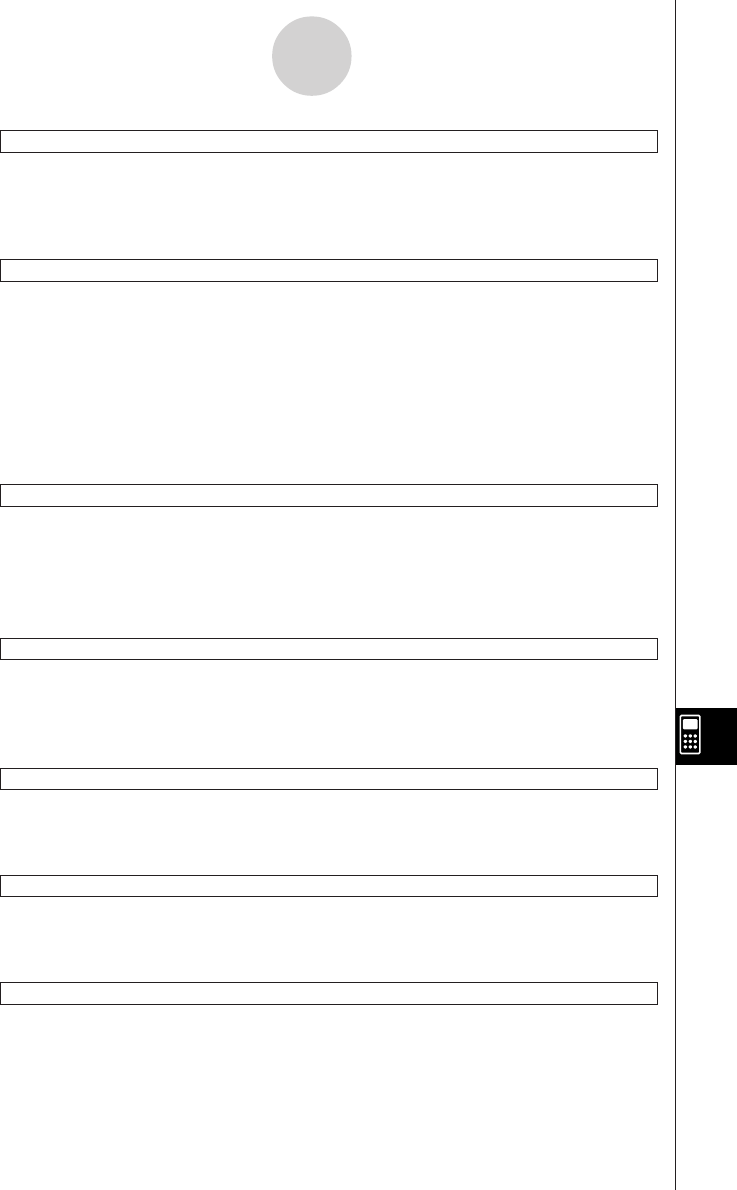User Manual
Table Of Contents
- Getting Ready
- Contents
- About This User’s Guide
- Chapter 1 Getting Acquainted
- Chapter 2 Using the Main Application
- 2-1 Main Application Overview
- 2-2 Basic Calculations
- 2-3 Using the Calculation History
- 2-4 Function Calculations
- 2-5 List Calculations
- 2-6 Matrix and Vector Calculations
- 2-7 Using the Action Menu
- 2-8 Using the Interactive Menu
- 2-9 Using the Main Application in Combination with Other Applications
- 2-10 Using Verify
- Chapter 3 Using the Graph & Table Application
- Chapter 4 Using the Conics Application
- Chapter 5 Using the 3D Graph Application
- Chapter 6 Using the Sequence Application
- Chapter 7 Using the Statistics Application
- 7-1 Statistics Application Overview
- 7-2 Using List Editor
- 7-3 Before Trying to Draw a Statistical Graph
- 7-4 Graphing Single-Variable Statistical Data
- 7-5 Graphing Paired-Variable Statistical Data
- 7-6 Using the Statistical Graph Window Toolbar
- 7-7 Performing Statistical Calculations
- 7-8 Test, Confidence Interval, and Distribution Calculations
- 7-9 Tests
- 7-10 Confidence Intervals
- 7-11 Distribution
- 7-12 Statistical System Variables
- Chapter 8 Using the Geometry Application
- Chapter 9 Using the Numeric Solver Application
- Chapter 10 Using the eActivity Application
- Chapter 11 Using the Presentation Application
- Chapter 12 Using the Program Application
- Chapter 13 Using the Spreadsheet Application
- Chapter 14 Using the Setup Menu
- Chapter 15 Configuring System Settings
- 15-1 System Setting Overview
- 15-2 Managing Memory Usage
- 15-3 Using the Reset Dialog Box
- 15-4 Initializing Your ClassPad
- 15-5 Adjusting Display Contrast
- 15-6 Configuring Power Properties
- 15-7 Specifying the Display Language
- 15-8 Specifying the Font Set
- 15-9 Specifying the Alphabetic Keyboard Arrangement
- 15-10 Optimizing “Flash ROM”
- 15-11 Specifying the Ending Screen Image
- 15-12 Adjusting Touch Panel Alignment
- 15-13 Viewing Version Information
- Chapter 16 Performing Data Communication
- Appendix

20050501
Inverse
Syntax: Inverse
䡺
<y or x graph number>
Function: Graphs the inverse of a function.
Description: Graph number range: 1 to 100
Line
Syntax: Line
䡺
<start point x-coordinate>, <start point y-coordinate>, <end point
x-coordinate>, <end point y-coordinate>
Function: Draws a line between two specified coordinates.
Example: Line 1, –2, 2, 3
Tip
• The line is not drawn if a start point coordinate or end point coordinate is outside of the current
Graph window.
NormalLine
Syntax: NormalLine
䡺
<graph number>, <x-coordinate>
Function: Draws a normal line.
Example: NormalLine 1, 2
Description: Draws a line normal to the graph at the specified x-value.
Plot
Syntax: Plot
䡺
<x-coordinate>, <y-coordinate>
Function: Displays a pointer at the location specified by the coordinates and plots a point
there.
PlotChg
Syntax: PlotChg
䡺
<x-coordinate>, <y-coordinate>
Function: Toggles display of the plot at the specified coordinates on and off.
PlotOff
Syntax: PlotOff
䡺
<x-coordinate>, <y-coordinate>
Function: Turns off display of the plot at the specified coordinates.
PlotOn
Syntax: PlotOn
䡺
<x-coordinate>, <y-coordinate>
Function: Turns on display of the plot at the specified coordinates.
12-6-18
Program Command Reference










